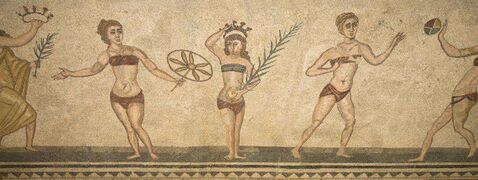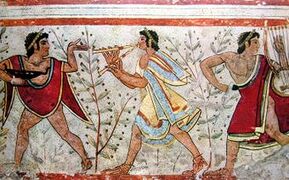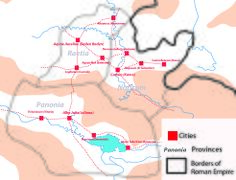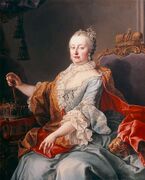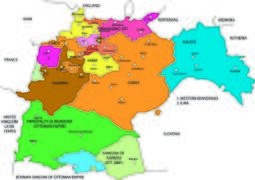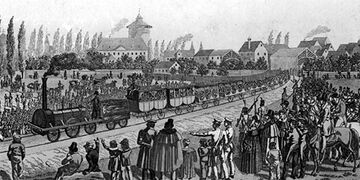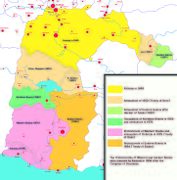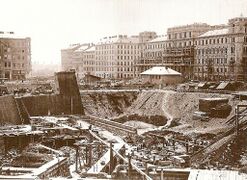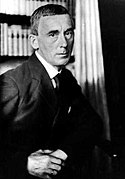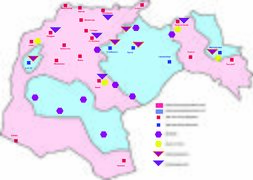History of Kamany
The first written records for the history of Kamany appeared in the Iron Age.
Antiquity
Kamany was inhabited by Celtic tribes 3200 years ago in the north and Truscian tribes in the south. Truscians developed between the 9th and 3rd century BC developed an agricultural civilization organised around independent kingdoms and civitas. The most famous, Vali, is home now to numerous archaeological discoveries. Celts in the north thrived around small villages and organised an intense trade between northern tribes and Truscians.
The Latin republic, originating from today Latin Republic, conquered the south of Kamany during the 3rd century BC. From 280 to 250 Rome won battles against local civitas and Truscans kingdoms. Celts in the north were conquered in the 1st century BC during the Celtic wars.
Romans rapidly established a network of roads and trade cities around the new provinces, Kanoj (Castra Batavar) and Kama (Comum) were founded by Roman merchants. The south of Kamany was administrated by the province of Panonia and the north was shared between the province of Raetia in the west and Noricum in the east. Romans, Truscans and Celts melted into a unique culture throughout this period; historians call this culture protokamanian or toscavian. Latin language slowly replaced Truscan and Celtic languages and people spoke an ancient version of ladino from the 5th century. Only a small part of the territory, in the east has been lost by Romans in the 1st century AD, in this part of the country, agricultural communities established small tribal kingdoms, such as the mythical Krak around present day Krakow.
Romans after the 3rd century lost a great part of their stability and the Empire started to become threatened by neighbouring tribes. Pescavians and Samarians launch military campaigns and raids towards toscavian cities; La Ventana (Durovigutum), and Belmondo (Aquae Mae) are both totally sacked in the late 4th century. At this time, Christianity develops in cities and extends to rural areas towards the end of 5th century. From this period, local landlords extend their power and establish romanized and ephemeral kingdoms in northern Kamany. The south is more prosperous and not affected before the great wars of the late 5th century. During these wars the last roman administrators leave power, roman armies are dismantled, and trade is dramatically reduced. Between the 6th and 9th centuries, these kingdoms continue to function under old Roman laws and traditions. Populations leave cities and feudalism emerged in this period.
Middle Ages
In the late 8th century the king of Galians (current France, west of Kamany), Desiderius, extends his kingdoms towards the east. He conquers vast territories in Kamany and annexes cities like Kama, La Ventana and Kanoj. After the treaty of Roviera (Rouvières in France) the Empire is divided between his four sons: Frankia in the west with, Campania in the north (north of Kamany), Caroz in the east (centre and east of Kamany) and Lombaria in the south (south of Kamany and norther Bosnia). The king of Caroz, Paulus the first, merges with Campania and Lombaria. During the 9th and 10th centuries, Paulian kings (descendants of Paulus) loosen their power and local lords (domini) become more and more influent. Notwithstanding this fact, Paulian kings keep their status of Defender of the Faith guaranteed by the Pope.
Despite regular tensions between lords (domini), between the 10th and 14th centuries trade thrives, especially along Fly River and the east-west corridor. Cities develop and population doubles during this time (from 2 to 4 million people). Local states, such as Erestakama in the west, Lombaria in the south, and Galicia in the east become fully independent by the end of the 13th century. A network of independence city-states (Kama, La Ventana, Genoa, Leij and Luanda) gains autonomy with negotiated charts at this time. In these city-states local craftsmen organise themselves in guilds and an emerging bourgeoisie working in banking and trade gains more and more power. By the 15th century, city-states are ruled by councils of local bourgeois and craftsmen; these councils elected a chief magistrate and leader called Dogo (from latin Dux) in Kama or Burgomaster (master of town) in Genoa. This organisation and trade allow arts and culture to develop in Kamany.
- Error creating thumbnail: File missing
The Dogo of Kama "Alberto de Sant Alban".
Modern times
During the 16th and the beginning of the 17th century the kingdom of Caroz, ruled by the Defender of the Faith extends its territory through marital unions and purchases of land; Grimaldis originating from Sant Sebastian rule this kingdom. Between 1525 and 1640 the kingdom triples its size and becomes one of the most influent powers in the region; only France in the west, England in the north and Ruthenia in the east are more powerful. Thanks to this period of peace, called Persean Renew, Kamanian merchants and artists travel from cities to cities and develop scientific knowledge.
The famous king Francesco Grimaldi, reigning from 1583 to 1625, surrounds himself with scholars and founds the Academy of Sciences of Kanoj. Nicknamed the Wise King he sends expeditions towards newly discovered lands across the Atlantic. Under Grimaldis’ name four colonies are founded in central and northern America.
With the development of sciences and an increasing enrichment of clergy, new religious ideas emerge. Protestantism and Calvinism spread in the north east of the country. This expansion leads to an increasing number of local uprisings and confrontations between local princes and newly established religious powers by the middle of the 17th century.
After Bosnia during the 15th century, the extreme south of Kamany is conquered by the Ottomans. Ottomans build fortresses along their northern border. These castles, mostly reconstructed from medieval ruins are still visible in the region of Algecira and the Valley of Murcia River. Ottomans respect local customs and religion but an important number on inhabitants convert to islam, especially to Bektashi Order. Ottomans, leaded by Kara Mustafa Pasha, are stopped in 1683 by armies of the Duke of Galicia, Jan Sobieski and Leopoldo Grimaldi of Caroz at the Pass of Fontana de Usagre.
Turning period of the 17th and 18th centuries
Confident enough after his victory of Fontana de Usagre in 1683, Leopoldo Grimaldi, a staunch proponent of Counter-Reformation, attempts a coup to repress Protestants in the city of Cartego in 1685. In reaction, protestant nobles of Cartego and northern cities of Kamany led ferocious protests: catholic monasteries are burned and Grimaldis’ mercenaries are attacked. The reaction of Leopoldo Grimaldi, the dispatch of troops in the region, headed to wider conflicts and the beginning of Protesting Wars. From 1685 to 1701 Protestant city-states and kingdoms on one hand and catholic ones on the other hand fight each other. The war ends with the Treaty of Benisola signed in April 1701. This treaty rehabilitates freedom of cult in all Kamanian principalities and kingdoms.
Consequences of Protesting Wars affect Kamany during the beginning of the 18th century. Indeed rural areas were heavily affected by raids and cities by sieges. In the meanwhile, an epidemic of plague, probably accentuated by famines and cold winters, kills 200 000 people in 1732-1733. This period of troubles was also marked regular uprisings, such as the Great Uprising of Campania of 1744. This era, from the beginning of the war in 1685 and the last uprisings in 1748, is called the Time of Despair by historians.
The context is also difficult for other regional powers. France and England are on bad terms because of colonial conflicts, religious influence of Jesuits in southern England and tensions around fisheries. The United Kingdom of Latin States and the Ottomans have fought for decades and are getting poorer because of these wars and an increasing distance from new trade routes. In the east, Ruthenia is eager to integrate the rich Duchy of Galicia and have a direct access to rich Korterzag harbours. Anna Maria Grimaldi, Defender of the Faith and new king of Caroz since 1740 and Kamanian nobles impatient to restore their credibility attack Ruthenia in September 1757 in order to protect the Duchy of Galicia. This attack is a complete disaster and starts the First Great Persean War. This war opposes two sides: Kamanian states by Caroz with Galicia, England and Portugal with France, Ruthenia and the United Kingdom of Latin States. Caroz and its allies win the war in 1763, this strengthens the power of Grimaldis, England, Portugal and proximity between Kamanian states.
At the end of the 18th century Kamanian states are closer than ever. They are united by military and trade alliances led by the kingdom of Caroz, the Duchy of Galicia and rich city-states of Kama and Genoa.
Revolutions
The influence of Enlightenments’ philosophy is clearly apparent in Persean cultures at the end of the 18th. In 1776, English colonies of northern America declare their independence and war against London. France eager to revenge from the War of Six Years declares war to England and its allies. American colonies gain their independence in 1788 but France and England are both heavily affected and largely indebted. In Caroz, the new king, Federico III Grimaldi is heavily influenced by philosophers implements reforms in 1783-1788: Government and administration is centralised, brutal punishments and serfdom are abolished and basic education of all inhabitants is promoted. Federico III is supported by a large part of nobility, the developing bourgeoisie and religious authorities. Most of these reforms are also implemented all over kamanian states. In 1789, France, ruled by the absolute monarch Louis the 16th implements large political reforms in order to restore its finance. These reforms are the beginning a French revolution which rapidly spreads all over Persa.
With a radicalisation of the Revolution after 1790, Louis the 16th, married to the sister of the new king of Caroz, Leopoldo II Grimaldi, flees to the Kamanian states in June 1791. This escape is an excuse for radical French revolutionaries to declare war to counter-revolutionaries (Caroz, most of Kamanian states, England and the United Kingdom of Latin States). At this time, Ruthenia takes this advantage to attack Galicia. During the war Francesco II Grimaldi leads Kamanian armies against French revolutionaries and sister republics of Campania and Brandebao established in western Kamany whereas General Kosciuszko leads Galician armies against Ruthenians. From 1798 English ships block French trade and weaken its economy. Besieged France is obliged to surrender and in February 1805, the Treaty of Saint Maur is signed between all parties. The treaty establishes a new Persean order and a reestablishment of previous royal families.
After the Treaty of Saint Maur of 1805 and despite the defeat of French revolutionaries, their ideal of freedom is still vivid; scholars and intellectuals organised into “freedom comities” advocate for extensive political reforms. Francisco II Grimaldi worried by possible popular uprisings proposes new reforms and a reinforced union with Galicia, Kama, Campania and Brandebao, they’re enacted by the Treaty of Hal in 1812. Victorious military campaigns of the united armies against the Ottomans and remaining independent kingdoms in the south increase bonds with between Kamanian states. Viktoro Laresimo, doge of Kama, and Francisco II Grimaldi, king of Caroz, undertake a tour through states and mobilise the attention of local nobility and bourgeois for a true union of Kamanian states. With the support of England and France, western states unify with the Treaty of Kama the 14th of January 1824. Kama is designated as the new capital, Francisco Grimaldi as the king and Laresino as the new chief of cabinet.
First industrialisation and territorial formation of Kamany
After its establishment the 14th of January 1824, Francesco Grimaldi, the king and former king of Caroz, and Viktoro Laresino, the chief of cabinet and former doge of Kama, gather a special council composed by nobles and bourgeois from Kamany. Between 1824 and 1826 this council writes the first constitution of the country in which previous states maintain a lot of competences such as internal security, currency and religious law. Kamany as a federal state, with Kama as its capital, is ruled by Francisco Grimaldi as the king and Laresino as the new chief of cabinet. When Francisco dies of a sudden fever at the age of 67, his son Fernando is crowned in June 1835.
The formation of Kamany is contemporary to the beginning of the Industrial Revolution. Starting in the late 1830s coal mining areas in the north and main cities host an increasing number of proto-industrial workshops. Trade along rivers and roads increases and the first railway is built between Genoa and Baarlouw in 1839. While in cities textile industry develops around ancestral knowledge and guilds, entrepreneurs found with local bankers steel plants. One of the first industrial fabric of steel of Kamany, Staal Kapenaer, quickly nicknamed Stalka, is considered as a symbol of this first industrialisation. This industrialisation transforms a mainly rural society into an urban one with an important working class located in developing urban centres. Despite this fast development, the east and the south of country remain rural and less developed.
Fernando Grimaldi, the king of Kamany, exhausted by difficult harvests in 1846 and 1847 and an increasing opposition of the new urban industrial bourgeoisie is threatened in autumn 1847 by an increasing discontent. In industrial urban centres, such as Kama, Genoa, Kanoj and Krakow, the difference between the “privileged” bourgeois and the working class is clear: working conditions, political rights, hygienic conditions are very harsh for these last ones. Rodrigo Meser, the chief of cabinet of the king, forbids the 25th of February 1848 the organisation of popular soups by socialist groups in Kama and fearing uprisings sends troops to the city. The 27th of February attacks are perpetrated by socialists and the 30th Kamaians march towards the Royal Palace in order to claim politic rights and a new constitution. New urban elites support these demands and request the resignation of Rodrigo Meser and the ratification of a federal constitution. The revolution spreads in big cities and after vigorous fights between royal mercenaries, troops and revolutionaries Fernando Grimaldi dismisses Meser and appoints Giorgio Sarauzo de Monca a liberal as the chief of cabinet in May 1848. Sarauzo de Monca and Francesco Grimaldi propose a new constitution for the country. Urban bourgeoisie supports this proposition but put pressure on nobles to accelerate the process. In July 1848, the constitution is signed by the king and elections (where only homeowners have the right to vote) are won in September by the Conservative-Federalist Party. According to the constitution a federal currency is created, the Kamanian Florin, federal taxes are implemented and the new Federal Guard is created. Remaining workers' and peasants' uprisings are repressed by the Federal Guard with the support of liberals fearing to lose control of the situation. The King, Francesco Grimaldi, weakened by the revolution and important critics from both liberals and conservatives resigns from power the 20th of December 1848 and his young son, Karlos Grimaldi is crowned king the 25th of December.
Renewed monarchy and territorial gains
The young Karlos Grimaldi, supported by liberal and conservative members of the parliament and highly influenced by his mother, Sofia Grimaldi, his mentor Luis Fonsea and the chief of cabinet Sarauzo de Monca, tries to gain the support of peasants, workers and bourgeois. In March 1850, motivated by this particular social and political context, new articles of the constitution are adopted: Universal suffrage is granted to all Kamanian men over 30, military conscription becomes compulsory for all men and the federal state grants now a total equality of rights for all citizens regardless of religion and ethnicity. For the first time a federal referendum is organised the 5th of April 1850 and the constitution is approved by 86% of voters. In June 1850 a new federal assembly is elected and the new Constitutionalist Party of Sarauzo de Monca reinforces its hegemony. Sarauzo de Monca served as chief of cabinet of the king until his retirement in 1871.
1850s and 1860s are marked by an important economic development. Economic liberalism and unified taxes in the kingdom are a formidable incentive for the development of trade and industry throughout the country. Agriculture is modernised with an intensive reparcelling and railway are built across Kamany. With the modernisation of the country Kama and other main cities are transformed: walls are destroyed are replaces by defensive forts, large avenues and squares are designed in city centres (Avenida Heroi and La Rambla in Kama, Planty in Krakow, Plaza Grimaldi in Kanoj and Avenida Koekel in Genoa) and impressive monuments representative of the new opulence are built (Opera and National Library of Kama, Art Museum of Genoa).
The years 1850-1880 are also marked by an impressive territorial expansion of Kamany. With an intensive lobbying with Persean royal courts, Sarauzo de Monca and Karlos Grimaldi obtained in 1852 the annexation of the Principalty of Monastir and the Sandzak of Kamero, populated by Ladinos but still administered by the weakened Ottomans, and the region of Lviv populated by Poles and controlled by the Cossack Hetmanate. Furthermore in 1857 during the War of Tatras against the Cossacks their state is shared between Ruthenia and Venice and Kamany gains the territory of Eastern Galicia. Eager to control a safe access to the sea, Kamany dismantles with the agreement of Persean powers the remains of the Ottomans in Bosnia from 1868 to 1884: coastal Dobrinja in fully integrated in the kingdom and the rest of Bosnia is considered as a protectorate administered under military rule.
Kamanian “Beautiful Epoch”
Years 1880-1914 is subsequently seen as a golden age, a “Beautiful Epoch”. This period in Kamany is characterised by optimism, economic prosperity, regional peace, colonial expansion and technological and cultural innovations.
After the retirement of Sarauzo de Monca in 1871, the Constitutionalist Party stays in power until the political crisis of 1882 when the Liberal Party is founded. After that a political bipolar system emerges between liberals and constitutionalists (which became more conservative) up till 1900s. This weakening of the Constitutionalist Party is the occasion for the king Karlos Grimaldi to deepen his power. With regular changes of chief of cabinet his role of neutral arbitrator becomes the one of a political facilitator, guarantying him a central position in the political game of Kamany. Moreover the image of “El Velo Senhor” (“the old man” in Ladino) of Karlos grows into one of the key stones of a developing national self-consciousness: the portrait of the king is ubiquitous in public spaces and state symbols. The emergence of socialists, economic development and a liberal bourgeoisie in 1900s led to the implementation of social reforms during this period: Strikes were legalised in 1905, a minimal welfare system was introduced in 1907, Sunday rest was established in 1909 and universal suffrage for all men over 21 in 1912. Even if Karlos Grimaldi was close to liberals and keen on laissez-faire ideologies, he supported these reforms in order to restrict the influence of communists and anarchists in the country.
After the total occupation of Bosnia in 1884 Kamany tries to enter the colonial game. A royal marine is quickly established in 1880 and extended in the following years. In the meanwhile the country started to show great commercial interest in several distant locations such as the Samoan islands, Morocco, Zanzibar and Taiwan. The Sultanate of Zanzibar becomes de facto a Kamanian protectorate thanks to the coup of Baleares in 1890. Zanzibar stays independent but Kamanians control trade and install a new sultan who abolishes slavery in 1902. After this, Western Kamanian Samoa is established as a protectorate in 1900 and the city of Salé and Tangier in Morocco become Kamanian harbours in 1908. Kamany doesn’t succeed to establish a protectorate in Taiwan but retains a concession in Tainan from 1909. In the immediate neighbourhood of Kamany, Bosnia is totally annexed in 1908. At the turn of the century colonisation is energetically promoted by liberals and the new radical left.
Prominent artistic movements of Kamany during this period are Symbolism in 1880s-1890s and Futurism and Art Nouveau in 1900s-1910s. In the field of literature, Sofia Haboma is the author of the series of novels telling the story of the Puna family and Joorn Heseld, wrote the famous “the Promise Land” in 1899 a social panorama of Genoa during the industrial revolution. Alfonso Somera, from Kama, is a famous composer of that time and actively worked with musicians from England and France. Major cities of Kamany, such as Kama, Kanoj, Genoa and Krakow were redeveloped during this period with the construction of Art Nouveau buildings, theatres, important railway stations, large avenues and square. Ronald Hess Seborga is the most architect of this period. In the field of visual arts, the most important artists are Jacek Malczewski, a famous artist of the symbolist movement of Galicia who often included himself in famous or mythological scenes, Jan Matejko who is considered as the greatest historical painter of Kamany, Alfredo Kubin a multi-skilled artist who is honoured for his obscure engravings and Humberto Bosioni a sculptor. Gustavo Klimt and Edmond Xielo are the most prominent representants of Kamaian Art Nouveau; they produced an impressive number of artwork and became symbols of the city.
The Second Great Persean War and the First Kamanian Civil War
See Also: First Kamanian civil War See Also: Second Great Persean War
Although Persa and Kamany experience one of the longest period of stability, tensions between powers rise. These rivalries are due to colonial issues, notably between France and Kamany in Morocco, the nationality question in Bosnia and Ruthenia and economic competition.
On 28 June 1914, the assassination of the king Karlos Grimaldi during a visit in Sarajevo, by Gavrilo Princip a Bosnian nationalist who was formed in Istria (Persa), leads to the outbreak of the crisis of July. In response Kamany issues an ultimatum to the governments of Istria who is held responsible of the attack. The government instantly reject the ultimatum and Kamany declares war the 5th of August to Istria. Consequently Russia and this country declare war to Kamany and a network of interlocking alliances enlarged the crisis from a local issue in southern Persa to one involving most of Persa. By the end of July the powers of Persa were divided in two alliances: Eurasia consisting of Kamany, Bade, Venecia, Vrdinska and Ottomans; and Oceania consisting of Istria, Dalmatia, Ruthenia, Russia and France. The United Kingdom of Latin States and Portugal joined Oceania in October 1914.
The Kamanian strategy was to invade Istria in less than a few weeks and push with the help of Bade, and maybe England, towards the French capital, Vincennes, in less than six weeks. Venecia, Vrdinska and Ottomans had the role to control the eastern front against Ruthenia and Russia. Kamanian and Badian armies surprised the Frenchs with their quick mobilisation and in October 1914 France was threatened at the battle of Marne by its enemies. Alas at the same time a secret alliance was established between England and France. Therefore, as a matter of fact England and Ernaf attack Kamany in November and occupy Genoa and the northern cities. In the west the front stabilises and armies settle in a war of attrition, marked by a long series of trenches. However, by contrast, in the east front lines exchanges of territories are more frequent. The battle of Zaporozhia led by Kamany and Vrdinska marks one of the greatest victories of Eurasia. Russia limits the advance of Eurasian armies with the battles of Duna and Vrdinska in 1916. In the southern front Istria, Dalmatia, Bulgaria and Banovina are conquered in less than a year by Kamany, Venecia and Ottomans. Kamany launch one of deadliest and longest attack of this war towards the United Kingdom of Latin States through the mountains of Sierra Madre in order to cut the country in two.
Economic restrictions due to war effort are very important. From December 1914, Persean powers are conscious of the long war that is coming, rationing is organised and populations experience severe restrictions. On the political side censorship is established by most of the belligerents. In Kamany the new King, Fernando II Grimaldi, leads the country but is more and more criticised for the uprising of Bosnia and severe defeats that the country experience and from 1916. After the Great Offensive of Oceania in March 1917 the army is completely disorganised and soldiers refuse to serve in several units. As a consequence a lot of local governments and political figures of Kamany advocate for the abdication of Fernando II Grimaldi and an armistice with Oceania. A period of troubles, when lootings and violence are common, starts: the Bosnian insurgents take control of Sarajevo and the south of Bosnia, a republican army allied with Oceania and composed of deserters and various armed groups takes control of several cities in Kamany. Face to a collapse of the army and the country the king resigns the 3rd of October 1917. A cabinet composed of prominent political figures from the parliament, the Council of People, officially rules the country and signs a permanent ceasefire with Oceania. Kamany enters in a period of troubles and violence continue for a few weeks as different armed bands and socialist movements control the country and no clear authority rules Kamany.
Veterans from the frontline started to return home by Christmas 1917 and organise into groups of friendship and assistance. These groups of friendship pledge allegiance to the new Council of People and locally enforced order. In January 1918 the parliament of Kamany gathers in an extraordinary session in order to organise the succession of Fernando II and retake control of the country. Tensions between the communists and socialists, still officially Marxist but increasingly oriented towards reformism, explode and communists refuse to endorse the Council of People. The ruling coalition composed of socialists, liberals and constitutionalists decides to engage negotiations with Oceania to postpone expected war reparations, send soldiers to Bosnia and cities controlled by worker councils and finally organise an efficient system of food distribution for a population threatened by famine. The expedition of soldiers to Bosnia is a failure and thousands of them die in a mountainous territory controlled by Bosnian hajduks and riots expand to other cities: in March 1918, Genoa, La Ventana, Arava and are controlled by worker councils. An army is successfully organised in May 1918 and the communist uprising is victoriously beaten by the central government. However economic difficulties are still important and the government starts negotiations with Oceania in very bad conditions.
After long discussions the Treaty of Fontenay determines the fate of Kamany. The country loses important territories (Bosnia, east of Galicia), large portions of the country are demilitarised for 15 years and the size of the national army is limited, important war reparations are imposed and the whole colonial empire, except Zanzibar and Samoa, is confiscated. The country stabilises with the introduction of a new democratic constitution in October 1918. However the country is heavily weakened by four years of war and a civil war.
The Kamanian Regency
After the establishment of a new constitution Kamany became a parliamentary democracy, yet the status of the head of state has not been set because of tensions between constitutionalists and socialists and the country officially stayed a monarchy. However the popularity of Fernando II Grimaldi was too fragile to authorise his return in Kamany and it was thus decided to select a regent to represent the monarchy, Bernardo Faisola a member of the Council of People was chosen for this position in May 1919. During this period political troubles remained important throughout the country; communist insurgents after being expulsed from the cities in May 1918 formed rural guerrillas and regularly attacked new legal authorities, on the other side of the political spectrum, the former military groups of friendship continued to enforce law without any legal authorisation and harassed leftist organisations. On the economic side the situation was still hard for the population, as payment of war reparations was important and inflation and rationing continued until 1923.
In order to stabilise the economic situation, finance the reconstruction of the country and the payment of war reparations the government of Bernardo Feisola proposes a complete financial and state reform in 1923: a new redenominated currency is introduced, corporate taxes, capital gains taxes and income taxes are implemented and the state is reorganised into new provinces and police forces are reformed. This complete state reform allows the country to enjoy an increased global growth and to multiply the production of electricity by eight in a decade. The electrification of Kamany allows the development of radio, cinema and other industrial sectors such as automotive industry, cutlery and manufacturing industry. Between 1913 and 1931 industrial production has increased by 39 % as well as the average standard of living of all classes. At the same time, the political situation stabilises and rightist and leftist insurgents and defeated by the new police forces. The good economical and political condition allows the government, controlled by liberals, and the regent Bernardo Feisola to negotiate a new treaty with the winners of 1917. The new treaty signed in 1929 puts an end to war reparation payments and the demilitarisation of the country.
This period despite its political conservatism witnessed an important cultural and artistic development for the country. The Kamanian society heavily affected by the Second Great Persean war was receptive to new avant-garde movements, such as Dada, or Art Deco that were developing. Anielda Maila, Sophie Tabaer-Merckx, Ryszard Huelsenbeck, Hannah Ojta and Francisco Picabia, are the most famous visual artists from this period. These artistic movements had also a great influence in the fields of architecture, for example in the Scola Bauhaus founded by Walter Gropczyński, and literature with the poems written by Hugo Ball and the novel “All Quiet of the Western Front” by Enrico Maria Remarque.
Bernardo Faisola the Regent of Kamany
Edificio Oktogon in Kama in 1923, a typical Art Deco building of the Regency.
The poet Hugo Ball in 1921.
Selfportrait of the painter Anielda Maila
Sophie Tabaer-Merckx, Dada composition of 1920
The Second Kamanian Civil War and the First Republic
See Also: Second Kamanian Civil War
After more than a decade of economic development the world enters in a period of economic recession after the Economic Crash of March 1931. The government of Kamany faced a difficult situation because of the vulnerability of its economy which at that time depended on foreign loans and markets. As of February 1932 Kamany was incapable to reimburse a part of its external debt and the main private bank of the country Banko Regal de Financio, bankrupted. In this context, the socialists and liberals, who were former supporters of Bernardo Feisola, were eager to find a political explanation and solution to the crisis and advocated for his resignation. In order to control the situation, Feisola sought assistance from the army, which owed him a lot thanks to the treaty he negotiated in 1929. However, contrary to what he expected, senior officers were too divided to support any initiative and Feisola was overthrown by his political rivals in May 1932.
Immediately after the resignation of Feisola, the parliament sabotages itself and new elections were expected for September 1932. During the electoral campaign influent socialist members of the parliament advocated for the establishment of a republic and organised protests, occupations of factories and town halls all over the country. At the same time, conservatives pretexting a risk of civil war or attacks from abroad mobilised veterans and a large part of the rural population and asked for the return of a king in Kamany. Roberto Grimaldi, the son of Fernando II, in exile in Azores had then decided to come back and support the claims of conservatives. The liberals, on their side, split into two groups and supported both of the initiatives. As the economic situation did not meliorate bankruptcies continued and unemployment continued to increase. The 5th of September 1932 the socialists with the help of a large part of the liberals won the elections; two days after the republic was declared. In order to appease the situation religious authorities recognised the Republic and were immediately followed by a large part of the army. Eager to unite the country around them, the socialist and liberals proposed to prominent members of several parties to join their government. Forthwith the new government, led by Ernesto Zagao and called the Republican Front, tried to implement in its first 100 days several important reforms: a new concordat was negotiated, a new constitution was proposed, important companies were nationalised (banks, industries, railway companies), important investments in transportation and energy were proposed and a system of compensation for farmers was established.
However because of economical difficulties causing a devaluation of the Pound in December 1933 and attacks from the right and the monarchists the Republican Front was forced to slow down the reforms. This pause was not a success and the government was attacked by the communists at its left. Taking advantage of these troubles the monarchists brang back Roberto Grimaldi in May 1934 and immediately crowned him king of Kamany in the cathedral of Kanoj with the support of the local elite. This event was a fatal blow to the government which is overthrown the day after. Immediately an alliance was formed between liberals and moderate republicans meanwhile the remaining monarchists fled to Kanoj and joined the monarchist government. However, the putsch of Kanoj was a failure and the Monarchists merely controlled 15% of the national territory. However the republican government eager to demonstrate its ability to control the situation was slow to react and sent contradictory orders to its troops. These mistakes were the occasion for monarchists to extend their control and gain several cities. By November 1934 the country was divided in two and controlled by two different governments: the Republicans and the Monarchists.
As the situation was worsening day by day, the Republican government sought assistance to France and Korterzag by February 1935, however these countries in an uncomfortable political situation only accepted to open their borders to refugees and to not sell weapons to the Monarchists. Nonetheless the Latin Republic and Ernaf answered to this call and sent troops and material to the Republicans from October 1935. On their side the Monarchists received help from Ruthenia but were incapable to benefit from it because of their difficulties to control their territory.
Political confusion reached its peak when a coup was organised by a group of officers and parliamentarians in June 1936 in Kama. The parliament, which has not met since 1935, was dissolved and the country was administered by a committee of experts eager to rapidly defeat the monarchist troops. With this perspective, military units were reorganised, communists and anarchists were expelled and several officers were fired for incapacity, corruption or treason. Indeed Republican troops were extremely disorganised, corruption was widespread and political factions (communists, socialists, anarchists, liberals) hardly cooperated. The new Republican authorities succeeded to reorganise the armed forces and by the eviction of the communists and anarchists from their alliance attracted the support of Church officials. The Monarchists increasingly violent and ideologically extreme lost support from the local elite and the population from 1937.
The Second Kamanian Civil War was particularly violent and several cities such as Luanda, Kanoj, Feczy Gadanja or Mistrzejowice were bombed between 1935 and 1937 by both sides. Moreover civilians composed the majority of the victims and massacres occurred in the provinces of Arava, Licao and in Galicia. The war officially lasted from 1934 to March 1938 when Roberto Grimaldi was deposed but skirmishes between Monarchists and Republicans continued until 1941 in remote parts of the country.
Ernesto Zagao leader of the Republican Frontbetween November 1932 and May 1934.
the king Roberto Grimaldi (left) and Fernando Alvis, his minister of foreign affairs (right)
Salvatore Leone one of the leaders of the Republican forces from 1936.
Installation of the modernist state (1939-1942)
After the war, large parts of the country had to be reconstructed, notably the cities of Kanoj, Luanda and La Ventana which were heavily damaged, important communication axes were also destroyed and unusable. According to official reports of the time, as a consequence of the conflict the number of refugees reached 200,000 outside and 750,000 people inside of the country. According to the political pact established between the republican parties, general elections were expected after the war and scheduled for February 1940. However, after that, members of the newly created Movement for the Union (MPU) directed by Salvatore Leone, the new head of government, infiltrated strategic institutions of the country, such as the army and police forces. At the same time, Salvatore Leone and other prominent ministers used their offices to investigate on their political competitors, from the socialist and liberal parties, and brought corruption or morality cases against them. These lawsuits tarnished the electoral campaign and troubles multiplied throughout the country. Supporters of the MPU intensively criticised socialists and liberals for their role in the failure of the former republic and mobilised themselves against them in huge political rallies. In January 1940 the situation worsened, elections were cancelled by the government and the police forces arrested the leaders of socialist and liberal parties; this coup de force was quickly called the February Judicial Conspiracy.
After the coup the government, exclusively constituted of members from the MPU, suspended the constitution, all of the political parties and led a campaign to arrest opponents and critics of the party. These purges led to the imprisonment of more than 10,000 officials and about 15,000 citizens. Directly in June 1940 a referendum organised to confirm the installation of the regime gathered 76% of the votes. In order to consolidate his popular base Salvatore Leone and his cabinet immediately started to combat organized crime, prevalent since the second civil war, by giving special powers to provincial prefects. Their action, the nationalisation of key companies (banks, industries, and insurance companies), a financial reform and good diplomatic relations with Kamany’s neighbours favoured an improvement of the economical situation.
Achievements of the modernist state: golden years of Kamany (1942-1973)
Two years after the coup of the MPU the economical situation has greatly improved: inflation has decreased from 80 to 3% and unemployment from 24 to 15%. At the same time, important figures of organised crime were arrested and prosecuted. In June 1942, Salvatore Leone addressed a radio speech where he announced the success of his two-year political campaign and incoming changes in the political organisation of the country: The 5th of September 1942 the MPU is renamed the Modernist Party and declared the only official party of Kamany and backbone of the State organisation; the 10th of September a political police force, the POLPO, is created to monitor the implementation of reforms and state policies. POLPO officers will be trained in special schools and will provide officers to state administrations; between October and November civil servants were obliged to join the Modernist Party to continue their duty. At the same time the party democratised itself and became accessible to every citizen if Kamany. Leaders of the Modernist Party, eager to contain the development of a communist opposition announced in June 1943 the implement of a social pact: the Modernist State Principles. This pact addresses urgent and long issues such as the generalisation of social security and retirement for citizens, a renewed status for civil servants, the instauration of two weeks of annual leave and the implementation of a Five Year Plan monitored by the POLPO. This pact was approved by referendum, with 76% of “yes”, the 20th of July 1943, a positive sign for the leaders of the Modernist Party willing to maintain their popular base.
